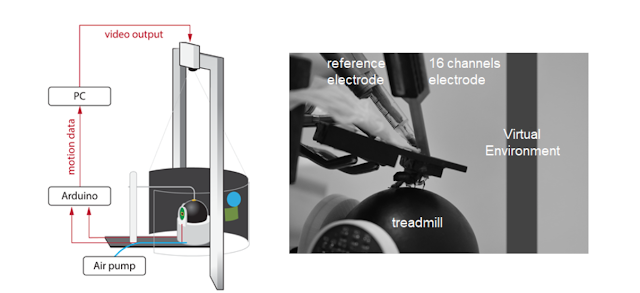“If the brain were so simple we could understand it, we would be so simple we couldn’t” Emerson W. Pugh, as quoted in The Biological Origin of Human Values
By Claire Rusch
I study how the brains of honeybees work. Why an insect and why the honeybee? Well, first off, insect brains are small [1], which is undoubtedly an advantage when trying to unravel the neural basis of complex behaviors. And there are plenty of examples of such behaviors in insects: some ants do agriculture, some paper wasps recognize each other individually, and bumblebees can be trained to pull a string and roll a ball [2]. Honeybees can learn to count, discriminate human faces and handle abstract concepts (sameness/difference, above/below, etc.). All of that with a brain of 1 million neurons (humans have billions)!
To study how the brain of a honeybee works, we developed a virtual environment (VE) – walking arena for insects. The animal is walking on a treadmill (a ping pong ball painted in black) and its motion is fed back to a screen. It is head-fixed, which is really important if you want to stick those tiny electrodes in the brain and not have them move around and destroy what you are studying each time the animal moves its head. In the VE, the bee can control its environment (closed-loop: if the animal moves, the surroundings move accordingly) or you can control it and watch if the animal tries to follow the stimulus or avoid it, for example (open-loop).
In our first study, we demonstrate that this VE could be used to study visual behaviors in honeybees. We trained bees to associate colored shapes with reward or punishment. First, we presented two shapes to the honeybee and recorded the duration of fixation for each shape, when the bee brings the stimulus in front of her and keeps it there. Bees tend to strongly fixate on one stimulus over the other and this preference was conserved across presentation. We then presented each shape separately and associated the preferred one with a mild punishment (a bitter solution) and the unpreferred one with a reward (sugar). After several associations, the two stimuli are presented together and the duration of fixation is again recorded. Honeybees learned to change their preference and they performed this visual task faster than classical visual learning protocols where the animal was entirely restrained.
This highlighted for me the importance of sensorimotor feedback when studying the neural basis of behavior. Since then, I have been studying how neural activity in the visual pathway can be modulated by that feedback. I use electrodes composed of 16 channels layered in diamond-shaped patterns and insert them in the medulla, a visual brain center, of a walking honeybee.
I present the colored shapes to the honeybee, in open-loop or closed-loop, at different levels of motor gain (motor gain is the relationship between the motion of the bee and the motion on the screen) and record simultaneously neural activity and behavior. Each experiment can last for hours, as bees can have their brain exposed, electrode inside it, and continue to walk, follow and fixate visual stimuli, and respond to sugar feeding (pretty impressive, isn’t it?).
The multichannel electrode allows me to record spiking data. Each time a neuron sends an action potential, the nearest electrodes record its shape. I compare the shapes in each set of contacts and manually assign the ones with similar shapes to the same cluster, each cluster being one unit (or neuron, but it could also be several neurons having exactly the same behavior and location). The signal-to-noise ratio is low as bee neurons are tiny and any electrical noise in the surrounding will be picked up [5], which is why algorithms of unsupervised clustering do not perform well (yet). It is a long, tedious process as there are many, many spikes to look at in a 3 hour long experiment. For each bee, I end up with the spiking activity of 6-10 units/neurons and the coincident walking behavior, visual scene and motor gain.
I am currently analyzing this big, multidimensional dataset. It is surely not an easy task but I think this data has great potential. It can help us better understand how neural activity in the visual pathway can be modulated by feedback from the environment, self-motion and how coherent the two are. I can ask questions on the level of a single neurons but also the population. So, stay tuned for our next publication on how the brain of a honeybee works!
To conclude and be honest, the truth is my favorite research-related task in the summer is not collecting or analyzing data but setting up and taking care of my hives. Beekeeping is one of the unexpected, marvelous things I learned in grad school. It is incredibly relaxing to watch the bees come and go, forage, clean, guard and live their busy lives.
Claire is a 5th year PhD student in Jeff Riffell’s lab
[1] Sometimes ridiculously small like the parasitic wasp genus Megaphragma, with a body length smaller than amoebas and 7,400 anucleate neurons! (Polilov, 2012)
[2] There are great reviews out there on this subject: Chittka and Niven, 2005 is one of my favorites. [3] Rusch, Roth, Vinauger and Riffell (2017). Honeybees in a virtual reality environment learn unique combinations of colour and shape. J. Exp. Biol 220:3478-3487. doi: 10.1242/jeb.164731
[4] Chittka and Brockmann (2005). Perception Space – The Final Frontier. PLoS Biol. 3(4):e137. doi: 10.1371/journal.pbio.0030137.
[5] As Dr. Justin Lieber once said: “In electrophysiology, “ground truth” is understanding why connecting the ground wire to 5 different random objects gets rid of the persistent hum in your recordings”






